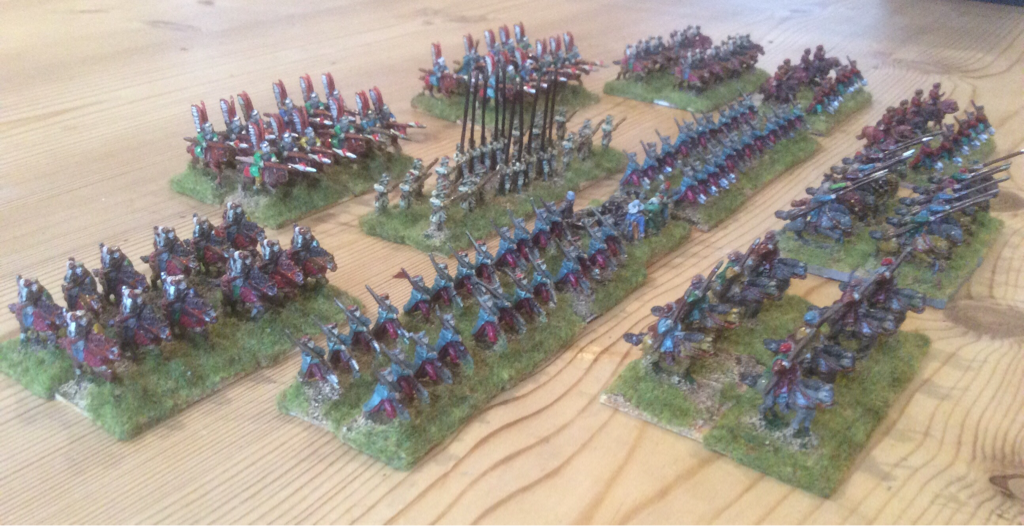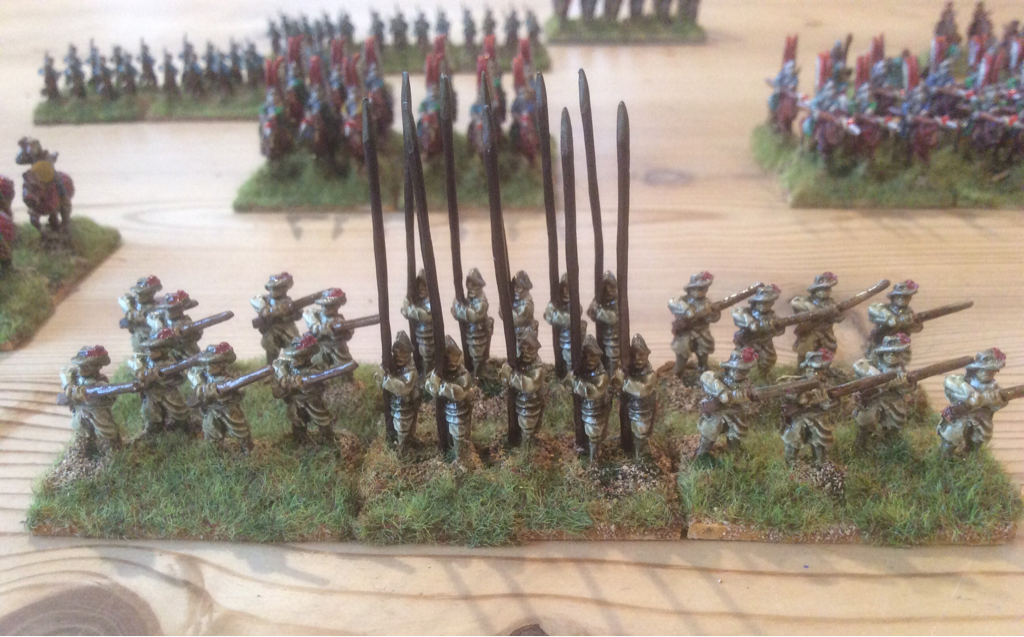|
I have uploaded pdfs onto the scenarios page, consisting of a quick reference sheet and Eastern Renaissance unit statistics for Warlord Games’ Pike and Shotte. The QRS includes a few house rules, for example for war waggons, as well as adjusted distances to fit figures mounted on 40mm bases. The unit stats include troop types not included in the rules but present in the 1660 campaign, built using the guidelines in the rule book. We have tested and adjusted the stats over several games.
0 Comments
On 14 November, a friend and I refought the ACW Battle of Olustee, using a scenario from the Longstreet Scenario bucket on the Honour Games Forum. It was written by Pete, aka Captain Darling, in Australia. There were about 75 stands a side, on a pretty open battlefield, give or take a pond, woods and fenced farmland. It was an escalating engagement, with reinforcements coming on at two entry points per army.
The Confederates made a tidy deployment of four regiments and a battery on table at the start. These formed a coherent front and started advancing while Federal reinforcements were still trying to reach the firing line. The Confederates called the tune for the rest of the game and the Federals had mainly to conform to Rebel movements. The game was tense as all Longstreet games tend to be. The Federals had some local successes but were outplayed and ultimately they crumbled, mainly because at key points on the field, there were more Rebel bases firing on fewer Federals. The Federals were also distracted by trying to man a long stretch of fencing in the centre of the line, but much closer to the Rebel entry points than Federal ones. With hindsight, the Federals would have done better to hold back and wait for their line to be reinforced, rather than gallop across the table hoping to hold a position where they were soon outnumbered. It was gratifying, reading an account of the real battle afterwards, to learn that our game followed a similar course to the real thing, with the same outcome. That's a measure of a good scenario so hats off to Captain Darling I have struggled for years to settle on a rules set for Renaissance gaming. I'm not sure I'm alone: it does seem to be a Cinderella period. I never took to WRG's original rules or DBR, although I rebased my figures to fit DBR conventions. We did have some fun games in the late 80s with Dodo Publications' ECW rules, which used simpler mechanisms than WRG and had quite a lot in common with some of today's rules. After a few years ignoring the period, I came back to it in the 2000s. I enjoyed reading Field of Glory Renaissance and was impressed by its army lists, but I just haven't got around to playing them. I may be missing a gem. Other rules bought but not played include Bacchus's Polemos ECW rules, as well as Captain General and Husaria, both by the Pike and Shot Society. They were all fun to read but Warlord Games' Pike and Shotte is the first set for many years that I actually played. I'm very glad I did as I really enjoyed it. We had to devise additional unit profiles to allow us to field Muscovite and Cossack armies and we toned down the factors for Polish Hussars (they were good but not superhuman) but otherwise the rules play very well. We also played a game using Honour Games' Maurice, which was certainly fun and I expect we'll play it again as one or two regulars don't like the command rules in Pike and Shotte. But for my money, Pike and Shotte is currently the best set for this theatre and period.
It may seem contrary not to have picked up the Wargamer's With Fire and Sword, which I know is highly regarded and was written specifically for the 17th Century. I have bought a lot of their figures but the rules seem a bit too skirmish-focussed for me. The books are lovely and I will probably buy them some day but I always seem to have other things to spend my gaming money on. I was looking at a new set called Tercios at a Warfare in Reading last week. I nearly bought it but picked up Bolt Action instead. Then this week I read a very positive review of Tercios in Wargames, Soldiers and Strategy. Typical! Maybe next Show... I spent Saturday in Reading at Warfare 2015, my favourite wargames show. I bought a lot of terrain, some 25mm Numidians and Gauls, more 10mm ACW troops and the Bolt Action rule book. Bit of a feeding frenzy. This evening my friend Keith, who came up for the show and us staying over, set up a game of Blucher. We used a newly purchased Cigar Box Battle mat, some roads, a couple of building bases and the Hundred Days cards to replay D'Erlon's attack at Waterloo. It was a tense and enjoyable game in which the French broke Allied morale but with lots of their units close to fatigue. I already love the Blucher rules set, but am even happier that the cards allowed us to set up a game off the cuff that we completed within an evening. Even though I lost....
I have been adding to the background information on the website about the Russo-Polish 13-year war, specifically the campaign in Ukraine of 1660. The only English language account I have found of this campaign is on Wikipedia, which seems to be a summary version of the Polish original. It is a fascinating campaign with lots of potential for gaming, so I decided to describe it in a bit more detail in English. The campaign produced, in order, a meeting of vanguards; a set-piece field battle (or nearly); a fighting retreat across a river crossing; a siege; several break-out attempts; an assault on a fortified hill; and the surrender into captivity of a whole army. With three field armies and limited geographical objectives, it makes for a manageable but interesting wargames campaign.
I hosted four games last year to refight the main engagements of the campaign,, using Warlord Games' Pike & Shotte rules and my 15mm figure collection. We expanded the P & S army lists to reflect all of the troop types involved but otherwise the rules worked very well. I plan to put the scenarios on the website, in a form that I hope can be adapted to different rules. But as this campaign and indeed this war is so little covered in the English language, I will include more of the background and explain how I put the material together, starting with sources. I will then describe the orders of battle and how these break down into wargame units. (Be warned now that while Polish Hussars do appear on the table, they are a very small part of the army by this stage in the century. Paint up your Pancerni and Tatar horsemen: you'll need lots of both). This is the first Polish Renaissance army that I bought, ready painted, in 1985 (or 86 when the figures actually arrived). I bought a ready-planned WRG force for the time of the siege of Vienna in 1683. Some of the sculpts are a bit crude by today's standards but I still love the dynamism of the poses, especially the Hussars with lances couched. Sadly, the ratio of Hussars to other troops is much too high for the 1660s, so ever since I started organising armies to fit historical orders of battle, most of my hussars have stayed in their box. Likewise, the Foot in blue jackets are fine for the 1680s but not earlier, so they, too, rarely turn out to fight. The Pike and Shot, on the other hand, are essential to a 1660s army and I've had to supplement my original White regiment with several others
The figures are based with a 40mm base frontage and organised the same way as units for Field of Glory Renaissance. I own the rules and army lists but have never actually played FOGR. I probably need to learn from experienced players because on the few occasions I set out to play FOGR, I gave up trying to grasp the rules and used another set instead. |
Archives
November 2023
Categories
All
|


 RSS Feed
RSS Feed